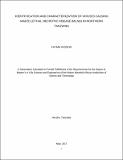| dc.description.abstract | Maize Lethal Necrosis (MLN) is a viral disease in maize currently reported in eastern and central Africa countries including Kenya, Rwanda, Uganda, Ethiopia, Congo and Tanzania. The disease is caused by Maize Chlorotic Mottle Virus (MCMV) in synergism with Sugarcane Mosaic Virus (SCMV), Wheat Streak Mosaic Virus (WSMV) or Maize Dwarf Mosaic Virus (MDMV). The present study aimed at assessing farmers' awareness of the spread and loss due to MLND, identify and characterize the causative viruses in Kilimanjaro, Arusha and Manyara regions in Northern Tanzania. Past experiences of the occurrences and losses due to MLND were assessed by interviewing maize farmers (n = 137) in the regions between April and June, 2015. Disease prevalence was assessed after the awareness survey based on direct observation and counts of symptomatic maize plants in quadrants within individual farms (n = 41) across villages within different agro-ecological zones (AEZs). Viruses causing MLND were detected in maize leaves by Double Antibody Sandwich-Enzyme Linked Immuno Sorbent Assay (DAS-ELISA), Reverse Transcription-Polymerase Chain Reaction (RP-PCR) and Next Generation Sequencing (NGS) - Illumina MiSeq. Based on interviews, 99% of the farmers were aware of MLND symptoms. About 51.8% of farmers had experienced MLND in three subsequent years (2013 - 2015). The disease was said to have caused total crop failure in the majority of the farms (88%) in 2014. The prevalence of MLND differed across regions (P = 0.0012) and villages (P < 0.0001) but did not differ across AEZs (P > 0.05). The highest prevalence was recorded in Kilimanjaro with 22% symptomatic maize plants followed by Arusha (14%) and Manyara (10%). Of all the samples collected, 65% were positive for SCMV by DAS-ELISA test and 97% positive for MCMV by RT-PCR test with a co-infection of 64%. The highest incidence of both viruses; MCMV (100%) and SCMV (98%) was recorded in Lyamungu Kati-Hai district. NGS analysis showed that, there were no Potyviruses other than SCMV found in the samples collected in the regions. Based on phylogenetic tree, MCMV from this study are highly similar to themselves and to the existing eastern Africa isolates (99% nt identity). However, SCMV from this study have significant genome diversity within themselves. They were found to be similar to the highly virulent SCMV isolate from Hebei-China and from Kenya (87 - 99% nt identity). Therefore, similar management practices including production of resistant maize varieties can be applied in the regions affected by MLND. | en_US |

